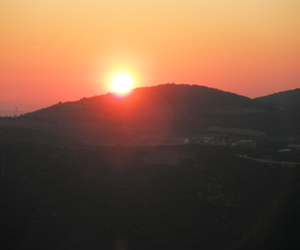Ahziv Hike
Duration: 7 hours
Level: Moderate
Length: 6 km
Notes: Bring lots of water, a bathing suit, flashlight, lunch and snacks
For the ‘Indiana Jones’ in us all, this magnificent hike features
refreshing swimming holes, wading through a cave and exploring a
Crusader castle.
How to get there
It is a 45-minute drive from Zefat, but well worth
the journey. From Safed, take Highway 89 westward. You will pass
through a few small towns en route. Just past Maalot, look for the
Monfort Castle sign. Turn right and follow the road uphill, in a
northwesterly direction toward Mitspe Hilla. There is a parking lot
at the beginning of the trail. See map for details. Make sure to
bring at least 2 litres of water per person. Wear swimming clothes and
bring along water shoes if you plan to swim.
Walk along the dirt road until you see a black and white hiking blaze
on your right. Follow the blazes into a beautiful forest. Shaded,
serene and level, the forest winds gently past oak, maple and laurel
trees. You will pass by another trail on the left with blue and white
blazes. If you choose to take that path, it will add an additional 1.5
km loop before rejoining the black and white blaze path. The black and
white trail gently winds downhill and then descends steeply via
steps on railroad ties. You will soon hear water splashing below. At
the river, follow the green and white trail to the right. It
will take you to a swimming pond. This is a perfect spot to rest, have
a snack and swim in the refreshing water. It is clean, cool and
shaded - a true oasis.
Ein Tamir Cave
After resting, continue walking along the green and white trail. You
will come across a smooth rocky area with several water filled holes
and further on, another swimming pool. This is another ideal area for
a dip. To the right of this, follow a tributary in the stone to a rock
face and look for an indent in the rock wall. This is the opening to
the Ein Tamir cave. Bring along your flashlight and a sense of
adventure. It is narrow and a bit scary at first, but well worth
exploring. The water is about knee deep and the cave narrows and then
opens up further along. This is a real treat for kids. (We had so much
fun with the cave and the water pools, our break ended up being two
full hours.)
To get to the Monfort Crusader Castle, double back along the green and
white blazes from the swimming pool and walk along the river. The
trail follows the river bed, often meandering from one side to the
other. It is shaded by fig trees and willows, while lush mountain
slopes soar above the canyon on both sides. The natural scenery is
truly breathtaking. Leaving the river, the trail is less shaded and
rather hot. Suddenly you will see the Crusader Castle above on your
left.
A Crusader Castle
Built on a steep cliff over 800 years ago, this is truly an
architectural feat. Do not be tempted to climb up to the ruins off the
trail. It is very dangerous. Keep on the red path as it will take you
past the castle and then wind up the mountainside, inviting you right
inside. It is a bit of a climb but the trail is gentle.
Once on top, the scenery is breathtaking, with views across the
mountains to the sea. One can imagine the Crusaders searching the
horizon for ships bringing them supplies. This fortress was first
built as an agricultural farm by the French De Milly family. They
named it Montfort, which in French means strong mountain. It was
conquered by Saladin in 1187. Yet just five years later, in the Third
Crusade led by Richard I of England, it was recaptured. The De Milly
family then sold it to the German Teutonic Knights who, aided with
money from Europe, renovated in and turned it into a fortress to
protect the Kingdom of Acre. By 1229, it was complete and the
magnificent fortress was renamed Starkenburg, or strong mountain in
German.
In 1266, the Mamluks tried to conquer the fortress but were
unsuccessful. They returned five years later, and in 1271, after seven
days of fierce battle, they were able to penetrate the southern wall
by digging underneath. The Knights surrendered and fled to Acre with
all of their treasures and possessions. The Mamluks destroyed the fort
to prevent anyone else from taking it over and it remains in ruins
till this day. In Arabic, it is referred to as Qaálat Qurein, which
means Castle on the Small Horn.
An archaeological dig in 1926 unearthed many exciting finds including
Crusader armour and spearheads. Coins and pot shards from the Second
Temple Period were also found, suggesting that the fort was built on
an established settlement that dates back to the Roman times.
After having climbed up to the summit in the heat of the day, our legs
weary and our water bottles emptied, we can begin to appreciate how
difficult it must have been to construct and defend this fortress.
Follow the red trail blazes to the other side of the fortress. The
trail continues gently upward to the top of the ridge and across. Your
car is about a 20-minute walk from this point.

